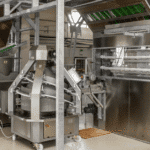In the fast-paced world of marketing and branding, the saying “a picture is worth a thousand words” has never rung truer.
Crafting visual narratives through custom labels has become an essential aspect of brand communication, influencing consumer perception and driving purchasing decisions.
In this article, we discuss and go into the exciting realm of design trends, unearthing the top three that are reshaping the landscape of custom labels.
1. Minimalistic Marvels: Less is More
In the age of information overload, simplicity emerges as a guiding principle in design. Minimalistic label designs on a roll are gaining traction as they capture attention with clarity and elegance. This trend focuses on stripping away excess elements, leaving only the essentials.
Real-Life Example: Apple’s Iconic Product Labels
Consider Apple’s product labels – sleek, minimalist, and instantly recognizable. The absence of clutter allows the brand message to shine through, creating a powerful visual impact. The use of clean lines, ample white space, and a limited color palette conveys sophistication and modernity.
The concept of “less is more” extends beyond aesthetics; it also facilitates quick comprehension. Consumers, bombarded with stimuli, appreciate labels that convey information concisely. Whether it’s a beverage, skincare product, or tech gadget, a minimalistic label design cuts through the noise, communicating the brand’s essence effortlessly.
2. Sustainable Stories: Eco-Friendly Labeling
As environmental consciousness continues to shape consumer preferences, brands are embracing sustainable practices, and this is reflected in label design. Eco-friendly materials like brown kraft and design elements that highlight a commitment to sustainability are at the forefront of the custom label revolution.
Real-Life Example: Coca-Cola’s PlantBottle Label
Coca-Cola’s PlantBottle label is a stellar example of sustainability in action. The label is made from plant-based materials, a step towards reducing the brand’s environmental footprint. The design tells a story of corporate responsibility, resonating with consumers who prioritize eco-friendly products.
Beyond materials, sustainable label design incorporates elements like recyclable packaging symbols, earthy color palettes, and imagery that reflects a connection to nature. These design choices not only align with consumer values but also contribute to building a positive brand image.
3. Interactive Imagery: Augmented Reality Labels
In the digital age, brands are leveraging technology to enhance consumer engagement. Augmented Reality (AR) is making its mark in the world of custom labels, transforming static images into interactive experiences.
Real-Life Example: Pepsi’s AR Campaign
Pepsi’s AR campaign stands out as a prime example of the interactive potential of custom labels. By scanning the label with a smartphone, consumers are transported into a virtual world where they can play games, watch exclusive content, and interact with the brand in unprecedented ways. This not only adds a fun element but also creates a memorable brand experience.
AR labels break the traditional boundaries of static imagery, allowing brands to tell dynamic, evolving stories. From revealing behind-the-scenes footage to providing product usage tips, augmented reality labels engage consumers on a deeper level. This trend opens up new possibilities for storytelling, creating a bond between the brand and the consumer that goes beyond the physical product.
Crafting a Narrative: The Art and Science of Label Design
In the realm of custom labels, the convergence of aesthetics and functionality is an art form. Design trends are not just about making labels visually appealing; they are about telling a compelling story.
Brands are no longer confined to a static, one-dimensional presentation; instead, they are creating narratives that resonate with consumers on a personal level.
The Psychology Behind Design Choices
Every element of a label, from color schemes to font choices, is a deliberate decision aimed at influencing consumer perception. Understanding the psychology behind these choices is crucial for crafting a narrative that aligns with the brand identity.
Color Psychology
Colors evoke emotions and associations. Warm tones like red and orange can convey excitement and energy, while cooler tones like blue and green evoke calmness and trust. The choice of colors in a label design plays a pivotal role in shaping the consumer’s emotional response.
Typography Matters
The font used in a label design communicates the brand’s personality. Bold, sans-serif fonts convey modernity and strength, while script fonts can evoke a sense of elegance and sophistication. The typography chosen contributes to the overall tone of the brand narrative.
The Future of Custom Labels: Personalization and Beyond
As technology continues to advance, the future of custom labels holds exciting possibilities. Personalized labels, incorporating elements like the customer’s name or personalized messages, are gaining popularity. This level of customization not only enhances the consumer experience but also strengthens the brand-consumer relationship.
Special finishing like gleaming spot uv and custom embossing increases the perceived value of both product and brand.
Moreover, innovations in smart packaging, integrating technologies like Near Field Communication (NFC) and RFID, are on the horizon. These advancements will allow brands to connect with consumers in real-time, providing product information, promotions, and interactive experiences directly through the label.
Conclusion: Designing Tomorrow’s Stories Today
In the ever-evolving landscape of custom labels, staying ahead means embracing innovation and understanding the power of storytelling. From minimalistic marvels to sustainable stories and interactive imagery, the top design trends are shaping the way brands communicate with consumers.
As technology, consumer preferences, and environmental consciousness continue to evolve, so too will the world of custom labels. The key lies in combining the timeless principles of design with the cutting-edge possibilities that technology affords. In crafting visual narratives, brands have the opportunity not only to showcase their products but to weave stories that resonate and endure in the hearts and minds of consumers.













